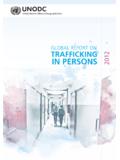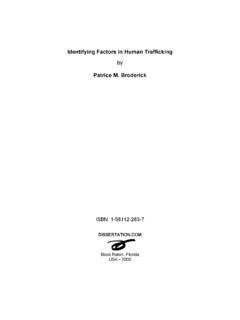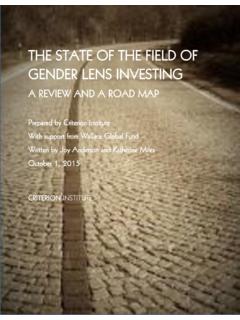Transcription of Can we put an end to human smuggling? - OECD.org
1 Migration Policy Debates OECD n 9 December 2015 1 In the first ten months of 2015, more than million illegal border crossings at the external border of the EU have been detected, a level never seen before in Europe. Available evidence suggests that irregular migration also persists in other parts of the world at high levels. Most of the migrants who use these routes put their lives in the hands of unscrupulous human smugglers and traffickers, who make big money out of this business. Tackling these crimes has become a top priority for policy makers. This edition of Migration Policy Debates scrutinises the factors that facilitate human trafficking, as well as the smuggling routes to OECD countries.
2 It synthesises available evidence and reviews existing policy tools for tackling such crime. It emphasises the need to undermine the business model of smugglers, including by reducing the demand for smuggling , fighting against corruption and addressing the root causes for irregular migration. _____ Can we put an end to human smuggling ? smuggling is a crime: smuggling of migrants takes place when a person facilitates the transportation, attempted transportation or illegal entry of another person into another country, with the aim of making a profit. It is a distinct crime from trafficking in persons, but in practice the two are often linked.
3 smuggling takes very different forms and may imply a large number of intermediaries: It can be structured as trans-national networks or, more often, comprise more or less connected informal organisations or individuals. It can be organised from origin to destination or made up of a succession of short travel routes. It can involve irregular border crossings or the use of fraudulent travel documents. smuggling is increasing: In Europe, human smuggling has grown significantly, notably via the oriental Mediterranean route but also through the central Mediterranean route. Other major routes of smuggling in Asia persist, although they are not increasing.
4 smuggling is also prevalent in Central America, with large number of people smuggled as they try to reach the United States. smuggling is enabled by corruption: This could be reduced by fully implementing OECD Guiding Principles on Combatting Corruption Related to Trafficking in Persons. smuggling can be tackled: Past experience of OECD countries show that co-operation with transit and origin countries can be instrumental to tackle human smuggling . In the longer term, however, this may not be sufficient if we cannot undermine the business model of smugglers. smuggling should be made high risk & low reward : In addition to reinforcing border controls and international police co-operation, policies should be implemented to reduce the profit for smugglers and to limit the demand for smuggling .
5 Undermining the profitability of smuggling without tackling the demand side carries the risk that smugglers will simply increase their offer on low-cost and deadlier routes. smuggling demand can be lowered: For refugees, one of the only available options to curb demand seems to be, at least in the short term, to offer more and quicker resettlement options. For economic migrants, curbing demand would entail increasing both prevention and information campaigns and employment options in origin countries and opportunities for legal labour migration, notably in sectors which are structurally dependent on undocumented migrants.
6 It would also require reinforcing controls and sanctions against the illegal employment of foreign workers. Ending smuggling requires new medium and longer-term approaches to development programs and development assistance: countries should move towards development-led strategies to counter smuggling , adapt development programmes to serve those prone to illicit migration, and increase employment opportunities at the regional level as well as promote intra-regional mobility. N 9 December 2015 Migration Policy Debates OECD n 9 December 2015 2 smuggling and trafficking The smuggling of migrants takes place when a person facilitates the transportation, attempted transportation or illegal entry of another person into another country, with the aim of making a profit (United Nations Protocol against the smuggling of Migrants by Land, Sea and Air, Art.)
7 3a). A different but related issue is trafficking in persons which consists of acts such as recruitment, transport, transfer, harbouring, receipt of a person, by means of abduction, fraud, deception, coercion, abuse of power or a position of vulnerability and others for the purpose of exploitation, including sexual exploitation, forced labour, and the removal of organs. smuggling of migrants is by definition always transnational and always illegal. Contrary to trafficking in persons, it does not involve coercion or deception of victims. Instead, human smuggling is committed with the consent of the persons being smuggled.
8 Once the two willing parties have conducted their business, they generally go their separate ways. human smuggling therefore does not involve an ongoing or new relationship once the destination is reached (Holmes, 2014). Different to the smuggling of migrants, trafficking in persons is not necessarily transnational and central to the definition of trafficking is that the acts are committed by fraud, deception or coercion, and with a purpose of exploitation. Once the destination is reached, trafficking involves an ongoing or a new relationship. It violates human rights of those trafficked, most commonly the right to personal autonomy, the right not to be held in slavery or servitude, the right to liberty and security of persons, the right to be free from cruel or inhumane treatment, the right to safe and healthy working conditions, and the right to freedom of movement (for an overview of trends and patterns see Kangaspunta in OECD 2015d).
9 Although two distinctively different crimes, it is, in practice, not uncommon that what starts off as smuggling of migrants can turn into a situation of human trafficking. For example, a pre-determined fee for entering a country illegally can once the border crossing has been completed be raised to an amount that the migrant cannot afford. In order to pay off this increased fee, and under threats from the smuggler to report the migrant s illegal border entry to the authorities, the migrant can end up in a situation of forced labour or sexual exploitation, making this person a victim of trafficking.
10 Even if smuggling does not turn into trafficking, the underlying and facilitating factors characterising both are intertwined, thus strategies and actions to curb smuggling may be applicable to trafficking in persons and vice versa. Emerging smuggling routes Some irregular migration corridors are well established, but precise smuggling routes may vary according to the evolution of border controls, geopolitical contexts and risks. Some new routes to OECD countries in and from Asia, Africa and Latin America have emerged recently (UNODC 2011a, EC 2015b). From Africa to Europe There are currently two main smuggling routes from Africa to Europe, crossing the Mediterranean between Libya and Italy (the central Mediterranean route) and between Morocco and Spain (the Western Mediterranean route).














